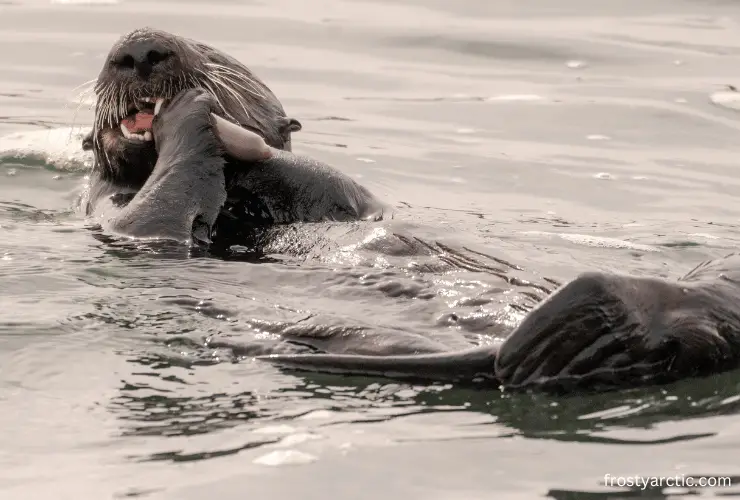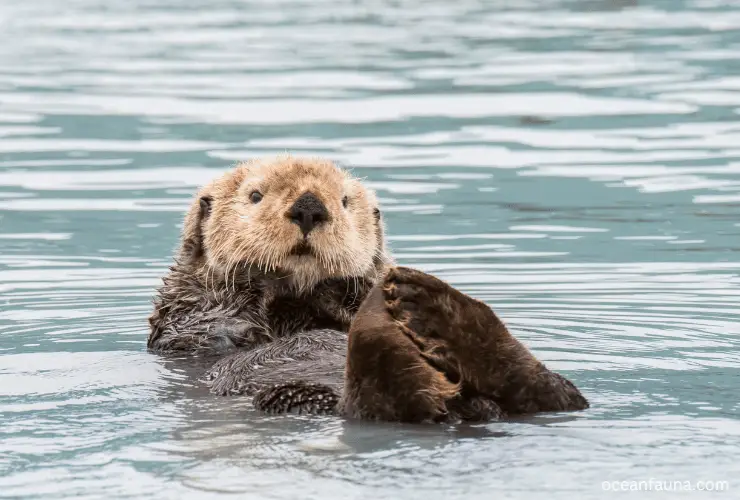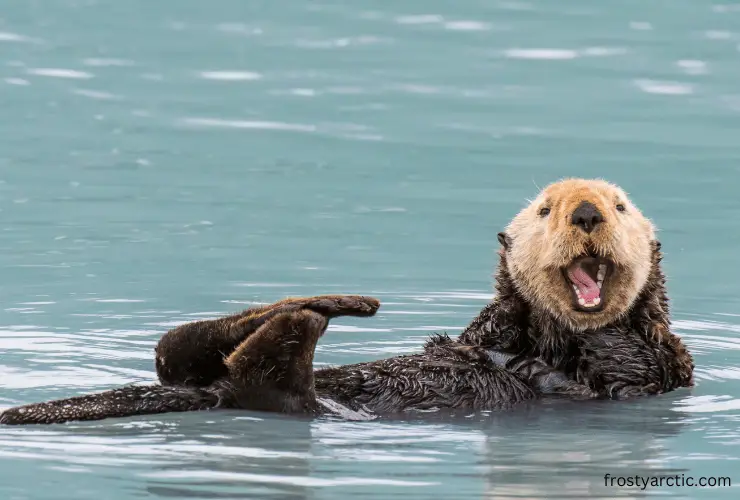Sea otters are dangerous wild animals. They can attack humans and have a powerful bite due to their strong teeth. You can find them soft due to their cuddly looks. But they are not friendly by nature. So, whenever you encounter a sea otter at sea or on land, try to keep a safe distance from them.
There are many reasons why sea otters are hostile to people. They worry about losing their home and way of life. Additionally, they are harmful to many other sea creatures, pets, and humans. They can hurt badly with nearly 80 lbs of force. Their bites can leave germs and bacteria behind.
Have you ever thought about why they are dangerous? Or do you want to know how dangerous they are and what safety measures can be taken to be safe from sea otter attacks? Let’s plunge into the crux of this topic and unravel the secrets behind these questions.
Are Sea Otters Aggressive or Friendly? Can They Be Pets?

Sea otters are aggressive. They cannot be kept as pets. As we know that they are active sea animals, it’s impossible to house-train them. They become sad when they are kept as pets in homes or training centers.
The feeling of sadness and less entertainment in homes leads sea otters towards aggressive behavior. Their stress and anxiety increase in cages and captivity. That’s why they become destructive to humans and other animals.
This is the main cause of their temperamental aggression. So, living as a pet in captive places is not an ideal life for otters. Sea otters make poor pets, according to the World Animal Foundation as well. We will discuss other reasons in another section below. ~ source
According to the report of the American Oceans organization, it is totally illegal to keep otters as pets in many states. Not only can they hurt others, but they can also stress and threaten other domestic animals. However, it doesn’t mean you must not respect them or have caution in dealing with them, even if they are dangerous. ~ Source
How Dangerous Sea Otters Are?
According to the study of BurkeMuseum’s official site, sea otters are vicious. They have firm jaws and their strong and powerful teeth have enough potential to crush the bones of their prey. Thus, their sophisticated jaws, skulls, and teeth combine to make them dangerous hunters.
Their hunting capacity even makes them capable of crushing the exoskeletons of pointy and pinny sea urchins. For instance, hard-shelled sea urchins have a 1 to 4-inch diameter and spikes everywhere. Still, it’s a small game for sea otters to break them into pieces. ~ source
Sea otters fight with other sea otters in addition to attacking humans. They attack and bite each other’s bodies, especially their shoulders and necks. Their skin is easily torn open by their razor-sharp teeth. After receiving wounds, they may contract an infection from one another’s germs and eventually pass away.
Do Sea Otters Attack Humans? Can They Kill Humans?
Sea otters attack humans. They can kill humans. Their sheer tenacity is due to the odd crocodilian meal. Although their population has declined in previous years, their attacks on humans were horrible.

According to a study by the Oceanographic Environmental Research Society in 2011, there have been more than 39 documented violent confrontations between sea otters and humans. About 33% of the perpetrators had rabies, and about 50% occurred in Florida.
The only documented deaths took place in captivity when otters defended their offspring by killing intruders while protecting their cubs. However, it is not always the case that otters chase, attack, and try to bite or kill a man. They often try to stay away from intruders and run away immediately. ~ source
Instances Of Sea Otters’ Attacks on Humans
Instances of known sea otter attacks on humans are rare. There are a couple of documented cases. According to an NCBI research paper, a 52 years old woman managed to survive after an attack on a sea otter in southern Quebec. Both of her legs were scratched and bitten badly. She had many open and deep wounds. ~ source
The research further states that 44 registered cases of otter attacks have been publicly published globally since 1875. Most of the sea otter attacks on humans were infrequent.
According to a BBC News report from December 10th, 2021, a man believed he was going to pass away right away. The incident took place in Singapore’s Botanic Gardens and involved Graham George Spencer. He said: ~ source
“I got more than 20 horrible and painful wounds from an otter attack. I thought these animals were going to kill me now. More than 20 otters were in front of me when I was walking. Most of them were pups and boys provoked them.”
On September 24, 2021, CBS News reported on some unusual behavior of otters. The news states that these animals are behaving mysteriously. It further added that otters are biting dogs and people in some of the latest cities in Alaska. ~ source
The Anchorage Daily News also reported that a 9-year-old boy was bitten by a sea otter. He was suffering from rabies and was taken to the emergency room on 25th September 2021. ~ source
The reports of the International Shark Attack File state that there is good news about the attacks on otters. It says only three cases have been registered every year about sea otter attacks since 1990.
Possible Reasons and Factors Influencing Sea Otters: Sea Otters Attack Humans

Every wild animal feels threatened and unsafe whenever another animal or a human enters their territory. The same is true in the case of sea otters attacking humans. There are many possible reasons and factors that influence sea otters to attack and even kill humans.
Let’s discuss a few reasons and factors behind this bad behavior:
Safety of Pups
Little and cuddly pups of sea otters are the first and foremost cause of sea otters attacking humans. Young sea otters are helpless and rely on their parents to protect them.
That’s why sea otters try to protect the pups and bite the unwanted entry in order to make them safe and secure. Thus, they are highly protective of their offspring.
Defense Mechanism
Sea Otters are hunting semi-aquatic animals and they know they can be hunted by humans and other animals. Attaching humans is mostly their defense mechanism against their hunt. They have been hunted for pelts dating back to 1700.
Even the Marine Mammal Commission (MMC) has declared sea otters endangered animals. That’s why sea otters rely on hunting and attacking for their survival. ~ source
Provocation
How can we miss out on this important factor that influences otters to attack humans? They attack if they feel threatened or provoked by human activities or actions. For example, attempting to touch them, approaching too closely, or interfering with their natural habitats can lead to defensive responses.
According to the Straits Times news, few wildlife experts assert that sea otters never attack unless provoked. According to numerous incidents, they attack people for a variety of other justifiable reasons. Source
Mistaken Identity
In rare cases, sea otters may mistake humans for other animals. They think they are hunting animals and can pose a threat to their young and territories. This misconception makes them attack innocent people sometimes. In addition to this, lack of habituation and unfamiliarity with humans is another reason behind their bites.
Food Competition
Human activities like shellfish harvesting or fishing can impact the availability of food resources for otters. They exhibit aggressive behavior toward humans when there is competition for limited food.
They also attack due to hunger. When they are hungry, they attack humans because they are omnivorous. They mistake humans for other animals that they normally hunt in their daily lives.
Illness and Injuries
Sick and injured sea otters show unusual aggression. These individuals react defensively or in anger. Moreover, if an otter has had negative interactions and experiences with humans in the past, an attack could result in an encounter.
Last but not least, they attack humans out of curiosity. They look at humans and try to find out if they are friendly or not!
Safety Guidelines for Interacting with Sea Otters

These playful animals, sea otters, can bob up and down, rob around in the seawater, and float on their backs. They are one of those animals that use tools such as rocks and stones to break the hard shells of their food.
This is also the main reason for their high metabolic rate. Unfortunately, they are not just playful but extremely aggressive too. They can turn on you if you get close to them.
Sea otters should be kept at a safe distance of more than 60 feet, or five kayak lengths, per DOI guidelines. It doesn’t matter whether you are in the water or on land; just stay away from them. ~ Source
Here are a few tips and tricks that will help you stay safe and sound when sea otters are around:
- Never try to feed sea otters. Never do this to yourself, even if you think they need to be fed from your hands. In California, it’s illegal activity to feed wild animals.
This act makes them feel dominant as they lose their fear of humans. Thus, they try to approach every other person to get food. In return, they can get hurt by humans and hurt them back too.
- Always observe them from afar. Use zoom lenses and binoculars to observe sea otters without disturbing them. This is one of the best ways to interact with them in their natural habitat.
- Always pay respect to the resting areas of sea otters. They often rest in groups called rafts. A raft is basically a group where more than 50 sea otters have hands in order to stay together and protect each other. So, you must not approach or disturb their natural behavior.
- Do not try to chase or corner them. This action can frighten them. Furthermore, it leads to potential injuries and accidents, both for humans and sea otters.
- Always be mindful of your behavior. You must keep noise levels low and also avoid sudden movements. It is because noise levels can startle them. A calm and quiet demeanor helps to maintain peaceful environments for humans and sea otters.
- Dispose of your trash properly in designated bins when visiting areas inhabited by sea otters. Sea otters can mistake litter for food and get entangled in it.
- Protected areas and regulations should be respected. Following guidelines set by local authorities or organizations where sea otters reside is necessary. It’s important to adhere to these regulations in order to protect them.
- Lastly, you can share safety guidelines with fellow visitors. The encouragement of responsible behavior around sea otters creates a sense of harmony.
So, sea otters should not be approached, touched, or fed. Always remember that the safety and well-being of humans and animals should be our top priority.
FAQs
Do baby sea otters have teeth?
Yes. Baby sea otters have 26 baby teeth that emerged at the time of their birth. These baby teeth are sharp and small but best for grooming and nibbling on soft food. Their other 10 teeth start developing after 3 to 4 weeks of age.
Can you touch a sea otter?
No, you cannot touch a sea otter. They look adorable but don’t fall over their cuteness. There are risks of getting bites and scratches from sea otters while trying to touch them.
Can I swim with a sea otter?
Big no. It is not recommended to swim with a sea otter. It is best to enjoy their presence without attempting to swim with them.
Can sea otters carry and spread diseases?
Yes. Sea otters can carry and spread diseases. Their bites can spread many species of bacteria that can cause severe infections. It can even lead to death if not tested and treated. A zoonotic disease is one of the illnesses that otters most frequently carry and spread. Sarcocystis neuronal, Toxoplasma gondii, rabies, and Acanthocephalans are some other commonly found diseases.
Conclusion
Sea otters are charismatic mammals and are generally ductile. However, they are pro in self-defense. The incident rate of otters’ attacks on humans is increasing day by day. The animal and wildlife protection authorities need to pay attention to this problem to protect otters and humans.



6 thoughts on “Are Sea Otters Dangerous? Do they Attack Humans?”